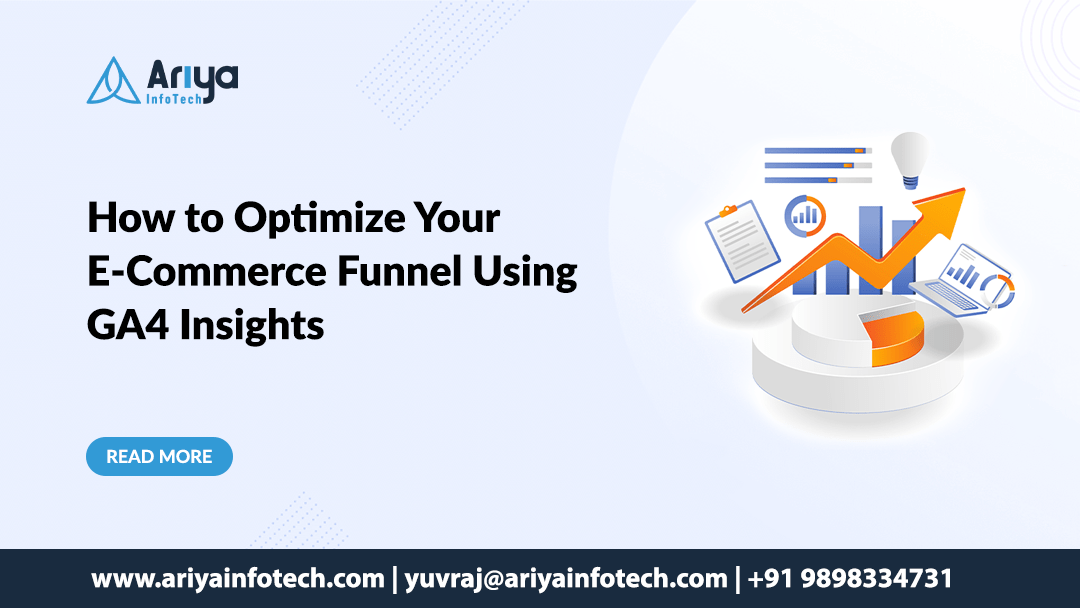How to Optimize Your eCommerce Funnel Using GA4 Insights

E-commerce businesses thrive on optimizing their sales funnels to maximize conversions and drive revenue. Google Analytics 4 (GA4) offers powerful insights into your customers’ journeys, enabling you to refine your strategies at every stage of the funnel.
In this blog, we’ll explore how to leverage GA4 to optimize your e-commerce funnel and turn more visitors into loyal customers.
This is custom heading element
The e-commerce funnel is the journey that customers take from discovering your brand to completing a purchase. It typically includes
- Awareness: Potential customers discover your website.
- Consideration: They explore products and consider purchasing.
- Conversion: Customers complete their purchase.
Optimizing this funnel requires a solid understanding of where users drop off, where they engage, and what influences their purchase decision. GA4 provides the tools you need to analyze and improve every stage.
Key GA4 Insights for Funnel Optimization
-
Track User Journey with Event-Based Tracking:
GA4 uses an event-based data model, which means you can track specific actions throughout the customer journey. From page views and product clicks to add-to-cart actions and completed purchases, GA4 allows you to capture every interaction that matters.
Tip: Set up key events such as product views, add-to-cart, and checkouts, and monitor how users progress from one step to the next.
-
Measure Engagement and Drop-Off Rates:
GA4 offers detailed engagement metrics that show how users interact with your site. By analyzing bounce rates and session durations, you can identify areas in your funnel where users lose interest or drop off.
Tip: If you notice high drop-off rates at certain stages (e.g., checkout), it could indicate friction points that need optimization.
-
Analyze Conversion Paths:
GA4 allows you to see the exact paths users take before completing a purchase. This is crucial for understanding which channels, products, or landing pages lead to higher conversions. With this data, you can focus on high-performing paths and improve others.
Tip: Use the “Path Exploration” report to see which pages are driving the most conversions and optimize the pages that are underperforming.
-
Leverage User Segments for Personalization:
GA4 enables you to create user segments based on specific behaviors, such as first-time visitors, repeat customers, or users who abandoned their carts. By segmenting your audience, you can tailor your marketing and website experience to different customer groups.
Tip: Run retargeting campaigns for users who abandoned their carts or offer personalized product recommendations to past customers.
-
Evaluate Marketing Campaign Performance:
By tracking campaign performance in GA4, you can measure the success of your marketing efforts at each funnel stage. You’ll get valuable insights into which ads, keywords, or channels are driving traffic and conversions.
Tip: Track UTM parameters to identify the most effective campaigns and allocate your budget accordingly.
-
Optimize Mobile and Desktop Experiences:
With GA4, you can track user behavior across devices. If you see significant differences in performance between desktop and mobile users, consider optimizing your site’s mobile experience, such as simplifying checkout or improving page load speed.
Tip: Ensure a seamless mobile experience by using GA4’s device tracking data to pinpoint any mobile-specific issues.
Conclusion
GA4 provides e-commerce businesses with a comprehensive view of the entire sales funnel. By tracking user behavior at every stage, you can identify friction points, optimize your funnel, and ultimately boost conversions. Use GA4’s powerful insights to make data-driven decisions that will improve your customer journey and help grow your online business.
Start leveraging GA4 today to get the most out of your e-commerce funnel optimization!


